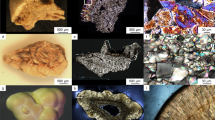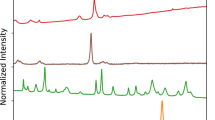Abstract
Kidney stones frequently develop as an overgrowth on Randall’s plaque (RP) which is formed in the papillary interstitium. The organic composition of RP is distinct from stone matrix in that RP contains fibrillar collagen; RP in tissue has also been shown to have two proteins that are also found in stones, but otherwise the molecular constituents of RP are unstudied. We hypothesized that RP contains unique organic molecules that can be differentiated from the stone overgrowth by fluorescence. To test this, we used micro-CT-guided polishing to expose the interior of kidney stones for multimodal imaging with multiphoton, confocal and infrared microscopy. We detected a blue autofluorescence signature unique to RP, the specificity of which was also confirmed in papillary tissue from patients with stone disease. High-resolution mineral mapping of the stone also showed a transition from the apatite within RP to the calcium oxalate in the overgrowth, demonstrating the molecular and spatial transition from the tissue to the urine. This work provides a systematic and practical approach to uncover specific fluorescence signatures which correlate with mineral type, verifies previous observations regarding mineral overgrowth onto RP and identifies a novel autofluorescence signature of RP demonstrating RP’s unique molecular composition.







Similar content being viewed by others
Data availability
Not relevant.
Code availability
Not relevant.
References
Scales CD Jr, Smith AC, Hanley JM, Saigal CS (2012) Prevalence of kidney stones in the United States. EurUrol 62:160–165
Williams JC Jr, McAteer JA (2013) Retention and growth of urinary stones—insights from imaging. J Nephrol 26:25–31
Letavernier E, Vandermeersch S, Traxer O, Tligui M, Baud L, Ronco P, Haymann JP, Daudon M (2015) Demographics and characterization of 10,282 Randall plaque-related kidney stones: a new epidemic? Medicine (Baltimore) 94:e566
Verrier C, Bazin D, Huguet L, Stéphan O, Gloter A, Verpont M-C, Frochot V, Haymann J-P, Brocheriou I, Traxer O, Daudon M, Letavernier E (2016) Topography, composition and structure of incipient Randall’s plaque at the nanoscale level. J Urol 196:1566–1574
Williams JC Jr, Lingeman JE, Coe FL, Worcester EM, Evan AP (2015) Micro-CT imaging of Randall’s plaques. Urolithiasis 43:13–17
CifuentesDelatte L, MiñónCifuentes J, Medina JA (1987) New studies on papillary calculi. J Urol 137:1024–1029
Murphy DB, Davidson MW (2013) Fundamentals of light microscopy and electronic imaging. In: Editor (ed)^(eds) Book Fundamentals of light microscopy and electronic imaging. Wiley-Blackwell, City, pp. xiii, 538 p.
Anderson J, Dellomo J, Sommer A, Evan A, Bledsoe S (2005) A concerted protocol for the analysis of mineral deposits in biopsied tissue using infrared microanalysis. Urol Res 33:213–219
Berezin MY, Achilefu S (2010) Fluorescence lifetime measurements and biological imaging. Chem Rev 110:2641–2684
Chen X, Nadiarynkh O, Plotnikov S, Campagnola PJ (2012) Second harmonic generation microscopy for quantitative analysis of collagen fibrillar structure. Nat Protoc 7:654–669
Campagnola PJ, Millard AC, Terasaki M, Hoppe PE, Malone CJ, Mohler WA (2002) Three-dimensional high-resolution second-harmonic generation imaging of endogenous structural proteins in biological tissues. Biophys J 82:493–508
Pramanik R, Asplin JR, Jackson ME, Williams JC Jr (2008) Protein content of human apatite and brushite kidney stones: significant correlation with morphologic measures. Urol Res 36:251–258
Evan AP, Lingeman JE, Coe FL, Parks JH, Bledsoe SB, Shao Y, Sommer AJ, Paterson RF, Kuo RL, Grynpas M (2003) Randall's plaque of patients with nephrolithiasis begins in basement membranes of thin loops of Henle. J Clin Invest 111:607–616
Schindelin J, Arganda-Carreras I, Frise E, Kaynig V, Longair M, Pietzsch T, Preibisch S, Rueden C, Saalfeld S, Schmid B, Tinevez JY, White DJ, Hartenstein V, Eliceiri K, Tomancak P, Cardona A (2012) Fiji: an open-source platform for biological-image analysis. Nat Methods 9:676–682
Peng H, Bria A, Zhou Z, Iannello G, Long F (2014) Extensible visualization and analysis for multidimensional images using Vaa3D. Nat Protoc 9:193–208
Daudon M, Williams JC Jr. (2020) Characteristics of Human Kidney Stones. In: Coe F, Worcester EM, Lingeman JE, Evan AP (eds) Kidney Stones. Jaypee Medical Publishers, pp. 77–97
Gulley-Stahl HJ, Bledsoe SB, Evan AP, Sommer AJ (2010) The advantages of an attenuated total internal reflection infrared microspectroscopic imaging approach for kidney biopsy analysis. ApplSpectrosc 64:15–22
Williams JC Jr, Worcester E, Lingeman JE (2017) What can the microstructure of stones tell us? Urolithiasis 45:19–25
Khan SR, Rodriguez DE, Gower LB, Monga M (2012) Association of Randall plaque with collagen fibers and membrane vesicles. J Urol 187:1094–1100
Sethmann I, Wendt-Nordahl G, Knoll T, Enzmann F, Simon L, Kleebe HJ (2017) Microstructures of Randall’s plaques and their interfaces with calcium oxalate monohydrate kidney stones reflect underlying mineral precipitation mechanisms. Urolithiasis 45:235–248
Evan AP, Coe FL, Lingeman JE, Shao Y, Sommer AJ, Bledsoe SB, Anderson JC, Worcester EM (2007) Mechanism of formation of human calcium oxalate renal stones on Randall’s plaque. Anat Rec 290:1315–1323
CifuentesDelatte L (1977) Etudes sur la structure des calculs à l’aide des coupes minces minéralogiques. J UrolNephrol (Paris) 83:592–596
Sivaguru M, Saw JJ, Williams JC Jr, Lieske JC, Krambeck AE, Romero MF, Chia N, Schwaderer AL, Alcalde RE, Bruce WJ, Wildman DE, Fried GA, Werth CJ, Reeder RJ, Yau PM, Sanford RA, Fouke BW (2018) Geobiology reveals how human kidney stones dissolve in vivo. Sci Rep 8:13731
Khan SR, Finlayson B, Hackett RL (1983) Agar-embedded urinary stones: a technique useful for studying microscopic architecture. J Urol 130:992–995
Amato SP, Pan F, Schwartz J, Ragan TM (2016) Whole brain imaging with serial two-photon tomography. Front Neuroanat 10:31
Winfree S, Hato T, Day RN (2017) Intravital microscopy of biosensor activities and intrinsic metabolic states. Methods 128:95–104
Hato T, Winfree S, Day R, Sandoval RM, Molitoris BA, Yoder MC, Wiggins RC, Zheng Y, Dunn KW, Dagher PC (2017) Two-photon intravital fluorescence lifetime imaging of the kidney reveals cell-type specific metabolic signatures. J Am SocNephrol 28:2420–2430
Spraggins JM, Rizzo DG, Moore JL, Noto MJ, Skaar EP, Caprioli RM (2016) Next-generation technologies for spatial proteomics: Integrating ultra-high speed MALDI-TOF and high mass resolution MALDIFTICR imaging mass spectrometry for protein analysis. Proteomics 16:1678–1689
Lovett AC, Khan SR, Gower LB (2019) Development of a two-stage in vitro model system to investigate the mineralization mechanisms involved in idiopathic stone formation: stage 1-biomimetic Randall’s plaque using decellularized porcine kidneys. Urolithiasis 47:321–334
O'Kell AL, Lovett AC, Canales BK, Gower LB, Khan SR (2019) Development of a two-stage model system to investigate the mineralization mechanisms involved in idiopathic stone formation: stage 2 in vivo studies of stone growth on biomimetic Randall’s plaque. Urolithiasis 47:335–346
Acknowledgements
We thank Sharon Bledsoe and Tony Gardner for assistance with data collection. This work was funded by the following grants from the National Institutes of Health: P01 DK056788; R01 DK124776, and S10 RR023710
Funding
NIH P01 DK056788; NIH R01 DK124776; NIH S10 RR023710.
Author information
Authors and Affiliations
Contributions
This is a multi-center study, and all authors were involved in data collection and manuscript review.
Corresponding author
Ethics declarations
Conflict of interest
The author(s) declare that they have no conflict of interest.
Ethical approval
Local Internal Review Board approved stone collection from patients.
Additional information
Publisher's Note
Springer Nature remains neutral with regard to jurisdictional claims in published maps and institutional affiliations.
Electronic supplementary material
Below is the link to the electronic supplementary material.
Rights and permissions
About this article
Cite this article
Winfree, S., Weiler, C., Bledsoe, S.B. et al. Multimodal imaging reveals a unique autofluorescence signature of Randall’s plaque. Urolithiasis 49, 123–135 (2021). https://doi.org/10.1007/s00240-020-01216-4
Received:
Accepted:
Published:
Issue Date:
DOI: https://doi.org/10.1007/s00240-020-01216-4




